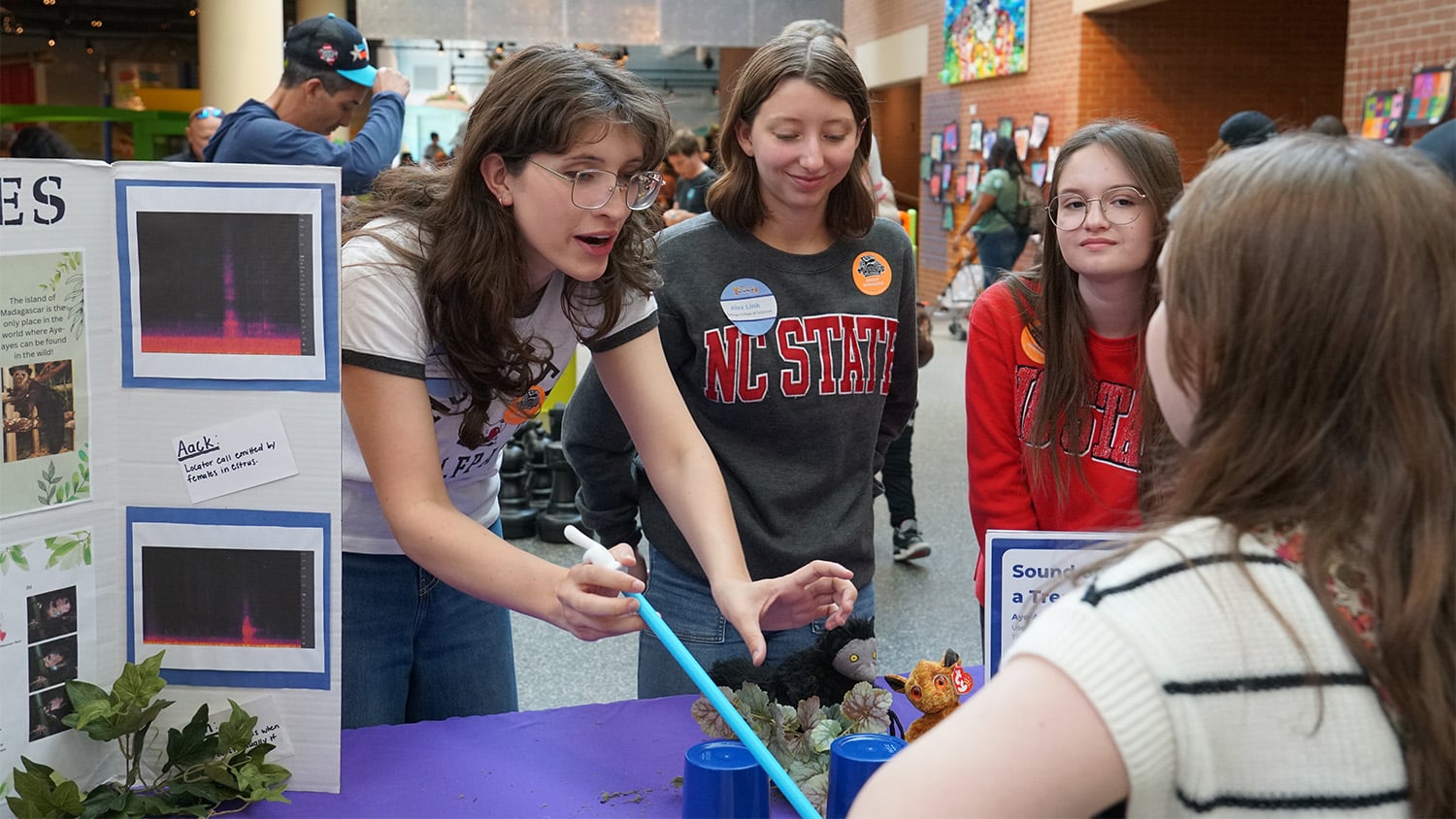Stepping Up for Hurricane Relief
NC State survived last week’s catastrophic storm in western North Carolina without much damage, though some research stations and farms are not fully operational in the decimated area. They are, however, serving as staging areas to get supplies to their communities in need.

Last week’s forecast for Hurricane Helene — developed by a handful of NC State-trained meteorologists and atmospheric scientists in the Greenville/Spartanburg office of the National Weather Service — was accurate but wholly unavoidable.
Forecasters in the office, which covers South Carolina’s upstate and most of western North Carolina, predicted that remnants of the Gulf of Mexico-formed storm would rapidly roll through mountains of Georgia, South Carolina and North Carolina and devastate the area as it was downgraded from a Category 4 hurricane to a tropical storm on its inland path.
“We knew this one was going to be bad,” says Trisha Palmer (M.S. Atmospheric Sciences ’04), warning coordination meteorologist for the GSP NWS office. “We were telling our partners in advance that this was going to be one for the record books, beginning last Monday and Tuesday.
“We wanted to let people know as much as we could that this would be one of the most significant weather events in the western portions of North Carolina in the modern era.”
That forecast came true, and more.
It was a catastrophic event that is really unlike anything western North Carolina has ever seen before.
Between Friday and Sunday, more than 30 trillion gallons of rain inundated the area, wiping away some small towns and cutting Asheville and Boone, the area’s largest municipalities, off from basic services like electricity, running water, and cellular, wireless and internet services. In North Carolina alone, more than 160 deaths have been reported.
“It’s going to take some time for us to fully piece together everything that happened meteorologically,” says Michael Brennan, three-time NC State graduate who is the director of NOAA’s National Hurricane Center in Miami. “We’re in the stage of trying to put it all together in terms of rainfall totals and damage.
“It was a catastrophic event that is really unlike anything western North Carolina has ever seen before.”
Just like in 1916, when two unnamed tropical storms converged over North Carolina’s Smoky Mountains, flooding created apocalyptic conditions. More than a century ago, a storm that began in the Gulf collided with a storm from the South Carolina coast over Asheville and dumped more than 22 inches of rain on the city in less than 24 hours.
It’s still the most rain ever measured in a single day in the state and the sixth most in U.S. history.
Helene rivaled that total, pouring more than 30 inches of rain over the course of three days. Property and infrastructure damage at this point is incalculable, and damage to three of North Carolina’s five largest economic sectors — agriculture, manufacturing and tourism — cannot yet be assessed.
Those who experienced it, however, saw unprecedented damage.
“It’s a mess,” says former NC State All-America basketball player Tom Burleson, the former planning director for Avery County. “Every utility pole in the county is down. We are being told not to expect power for four to six weeks.
“Everywhere you look is just devastated.”
For the most part, NC State’s Raleigh campuses had little damage, other than 70 or so minor leaks that often occur during heavy rainfall.
NC State field labs and research stations in the western part of the state were also spared major damage, even though they were in the direct path of the storm. There is still no power and water at the College of Engineering’s Minerals Research Lab in Asheville, while the College of Agriculture and Life Sciences’ Mountain Horticultural Crops Research Station in Mills River, the Mountain Research Station in Waynesville and the Upper Mountain Research Station in Laurel Springs are also still without both at their facilities. All remain closed at this time.
“NC State facilities and our remote sites survived,” says Allen Boyette, assistant vice chancellor for campus operations and maintenance. “There are places that are not operational right now, but there was not a lot of structural or physical damages that we know of.
“We survived pretty well.”
That has allowed university personnel to begin lending a hand to community partners and neighbors in the affected region, particularly the three UNC System schools — UNC Asheville, Appalachian State and Western Carolina — just as it did when hurricanes damaged campuses at UNC Wilmington and UNC Pembroke.
A team of nine emergency responders from NC State’s Division of Academic and Student Affairs left Raleigh for Asheville on Monday to assist rescue and recovery efforts based at UNC Asheville. Other volunteers will go there in the near future.
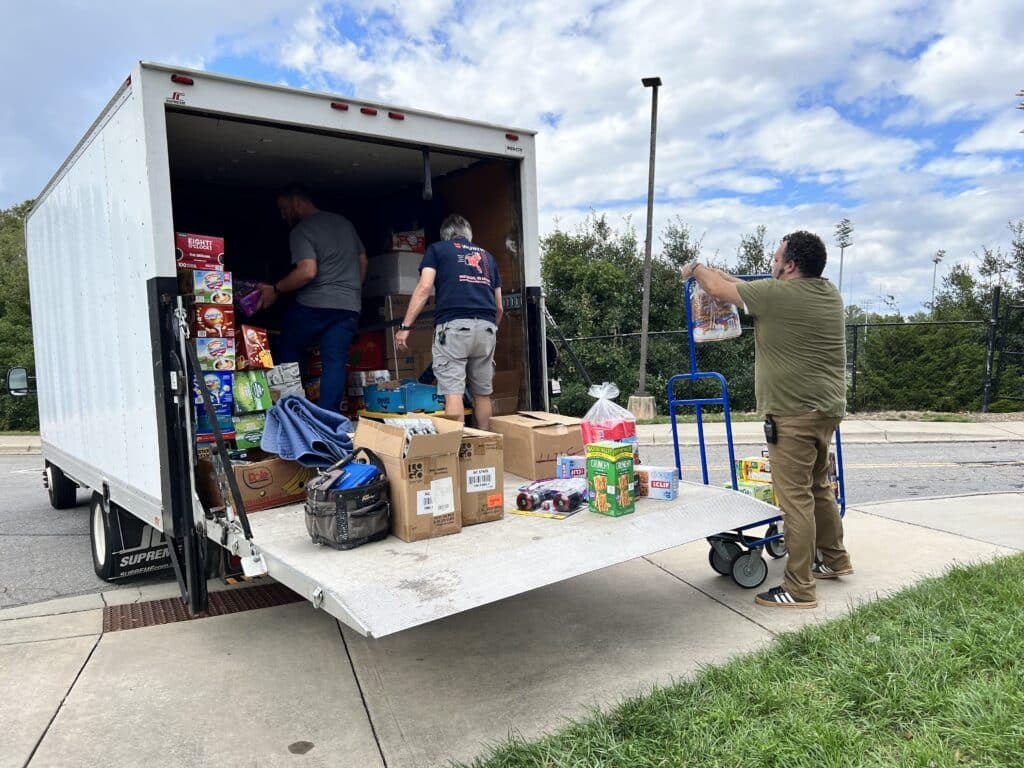
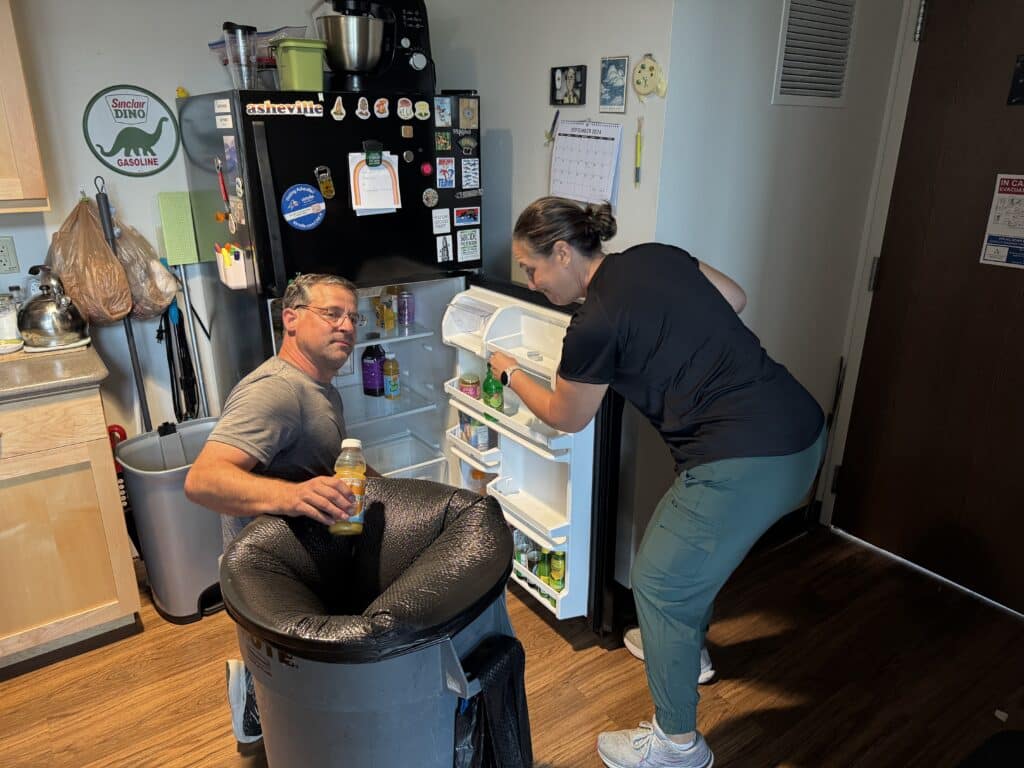
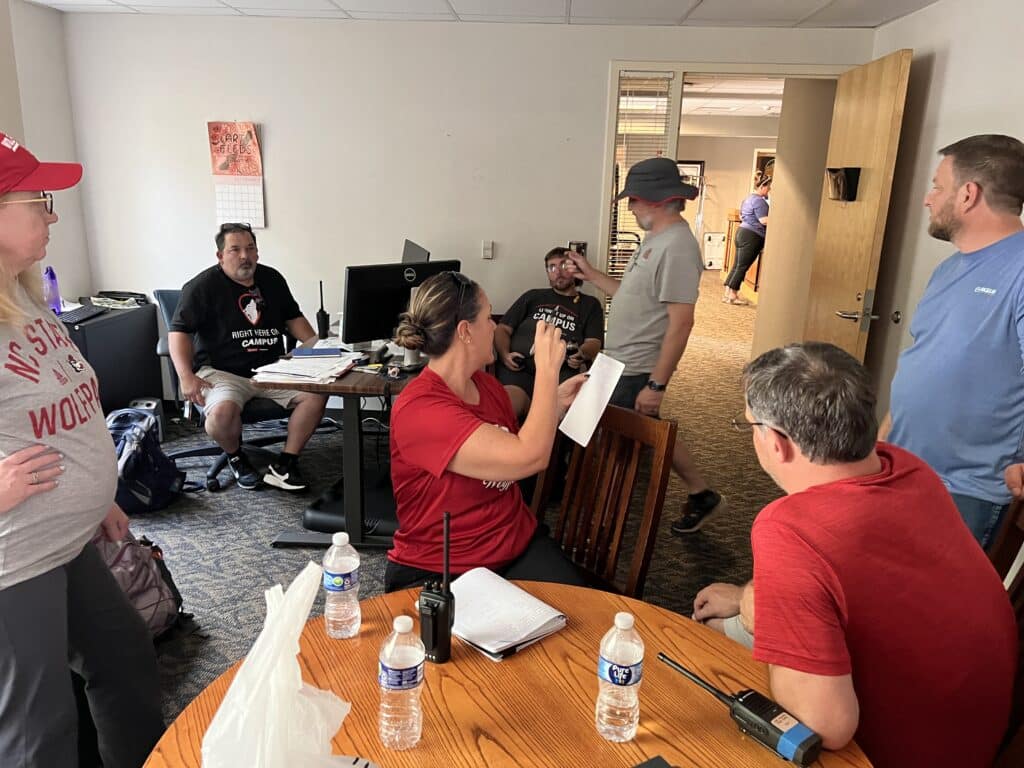
They spent three days helping to relocate students and clean out residence halls and other buildings on campus, which sustained some damage and is without water and power, but is not as decimated as its surrounding community.
“Campus here looks pretty good,” says Justine Hollingshead, assistant vice chancellor. “We spent time cleaning out perishable items and handing out water to people still on campus. This is a short-term effort, but this is going to be a long-term process to return to a sense of normalcy.
“We do have a psychiatrist with us from the counseling center to help high-risk students or personnel who are processing everything that has happened.”
Those from DASA who traveled to Asheville with Hollingshead were Pete Fraccaroli, Jimi Carpenter, Dale Lefler, Bryan Botts, Kevin Sutherland and Abinadi Ehrisman from University Housing, Lisa LaBarbera-Mascote from Student Success and Heather Rogers from the Counseling Center.
While electricity, water and other necessities are still scarce and recovery is just beginning in those communities, the NC State and its shared North Carolina Department of Agriculture sites are being used as local staging hubs to distribute donated supplies.
The NC Department of Transportation is using the 397-acre Mountain Horticulture station as a service hub because of its 2,100-gallon fuel tanks. One need there is for 5-gallon buckets with lids.
“Our stations, both NCDA and NC State owned, are transitioning to recovery hubs and staging areas for relief efforts in the community,” says Loren Fisher, assistant director of research for CALS. “They are well-linked with FEMA, local emergency management and the Forest Service in these efforts.”
Many of the Cooperative Extension facilities in the 26 western counties most affected by the storm are still without power and water, and not all have been in touch with damage reports. Cooperative Extension has set up a disaster site with a full list of resources for those in need. It also has a daily newsletter with safety and recovery information for those who subscribe.
Campuswide, many faculty and staff have begun collecting supplies to send to western locations. The items in high demand include diapers, disinfecting wipes, feminine hygiene products and other personal care items.
One of the biggest drives was started by football captain Davin Vann, a senior defensive lineman from Cary whose family owns a moving service. Vann, his parents and younger brother Rylan Vann, a redshirt offensive lineman, and their football teammates have all pitched in to organize the effort and load the supplies for transport to the Durham Rescue Mission, which will deliver everything to the western parts of the state.
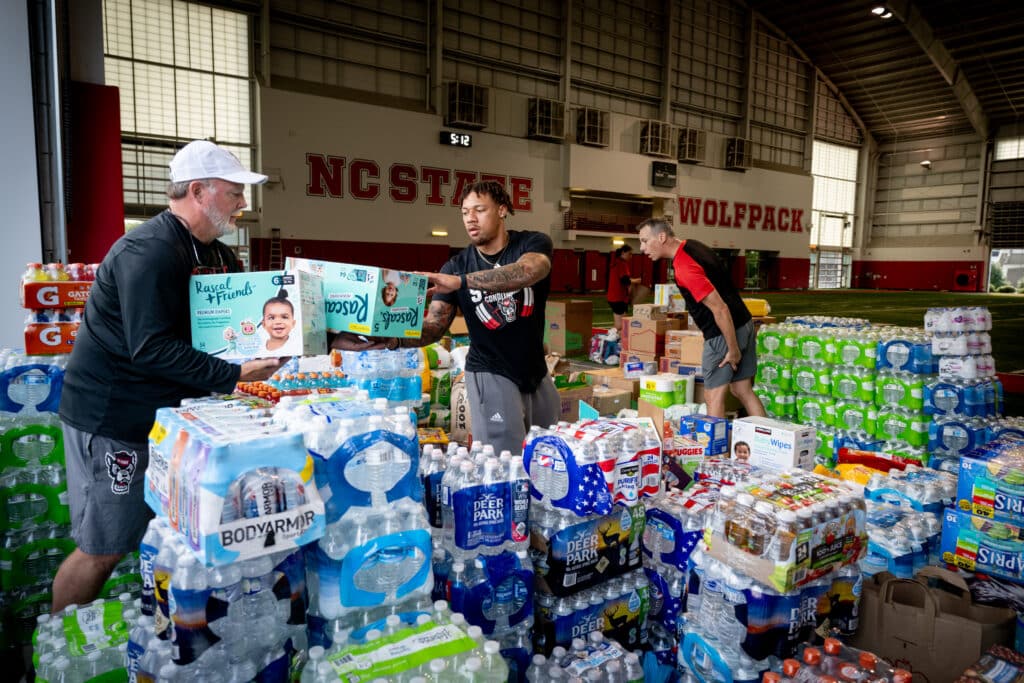
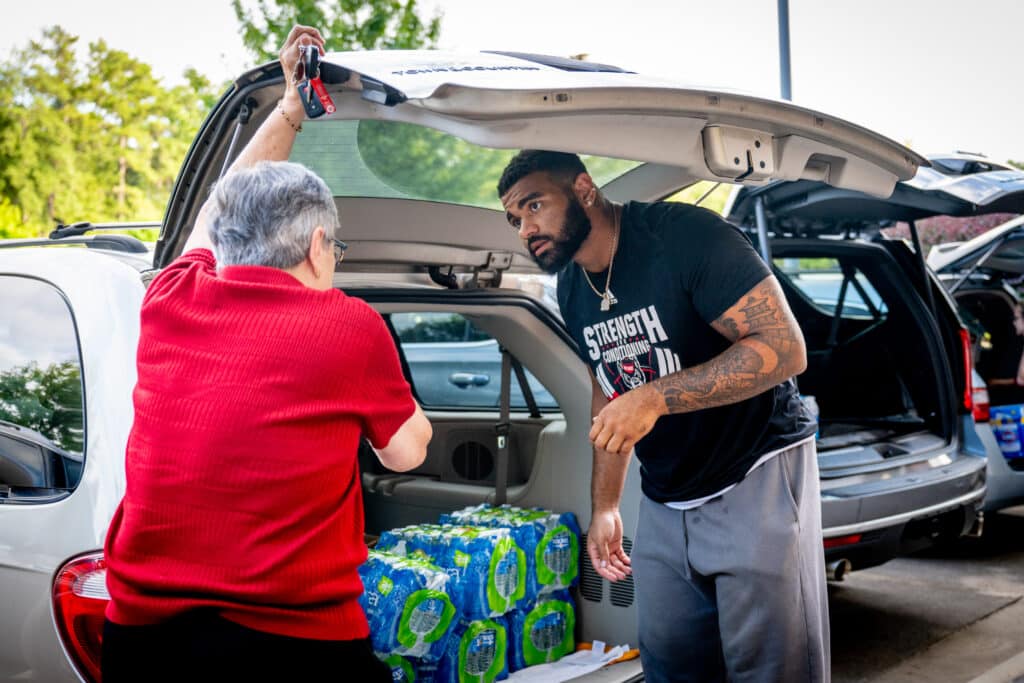
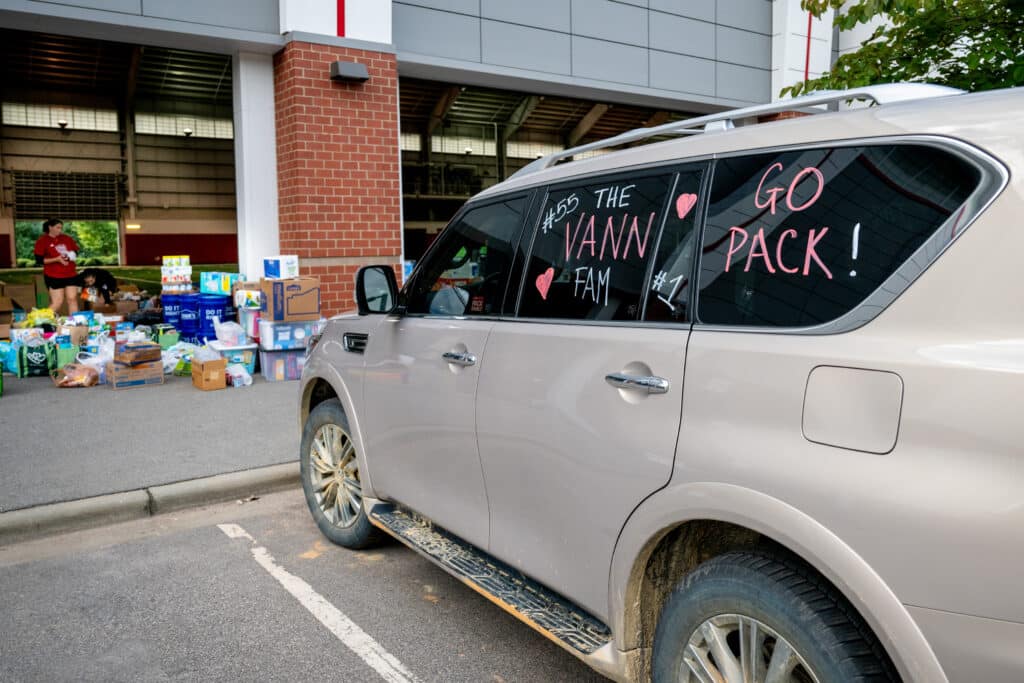
So far, football fans and others in the Triangle community have filled four box trucks with supplies and will be collecting more through Thursday. They hope to have a donation drive at Saturday’s noon football game against Wake Forest at Carter-Finley Stadium. Details will follow later in the week.
“I’m really surprised and happy at the response of the community,” Davin Vann says. “It really makes my heart feel good to see the Wolfpack community come through in this way to help people in need.”
How To Help
Outside of the football practice facility, another place to drop off supplies on NC State’s campus is the Lake Wheeler Road Field Lab, where CALS is collecting supplies to send to its three western research stations. So far, two trailer loads of goods have been shipped out. The field labs will continue to collect goods through Oct. 9. Once everything arrives at the research stations, they will be distributed by employees to members of the community who need them most.
Those donating are instructed to drop larger supplies off on the pallets located at 3591 Bill Gilbert Way. Leave smaller items at the office located at 4201 Inwood Road in the green plastic tote.
Needed supplies include fencing (posts, wire, etc.), bagged pelletized feed, pet food, buckets with lids, consumable paper supplies (paper towels, feminine hygiene products, toilet paper, diapers and wipes), 1-pound propane canisters for camp stoves, empty plastic fuel cans, large trash bags, flashlights and batteries, lamp oil, powdered or non-refrigerated milk, instant coffee, dish soap, laundry detergent, bleach, tarps, adult and children’s pain relievers, mops, brooms, paper plates, paper cups and plastic utensils, infant formula, and bottles.
Larger items include generators, mobile washers and dryers, chainsaws, dehumidifiers, box fans and heavy-duty storage totes and coolers. Get the most up to date information from Triangle Mutual Aid.
Other places to drop off goods and supplies include the Student Government suite at 4251 Talley Student Union and 3002 Engineering Building III.
To help students, faculty and staff at UNC System schools Appalachian State, Western Carolina and UNC Asheville, donations can be made to three specific emergency funds:
Donations can also be made directly to the North Carolina Disaster Relief Fund and the Hurricane Helene North Carolina Community College Response and Recovery Fund.
Finally, these three relief funds have been set up for students, extension and the College of Veterinary Medicine mobile unit.
- NC State Extension Disaster Relief Fund is helping Extension staff on the ground in western North Carolina as they bring resources and supplies to residents.
- VetMed Disaster Relief Fund helps the College of Veterinary Medicine deliver pet supplies to impacted communities.
- Student Emergency Fund will be assisting students from western North Carolina with financial needs as they arise.
- Categories:


